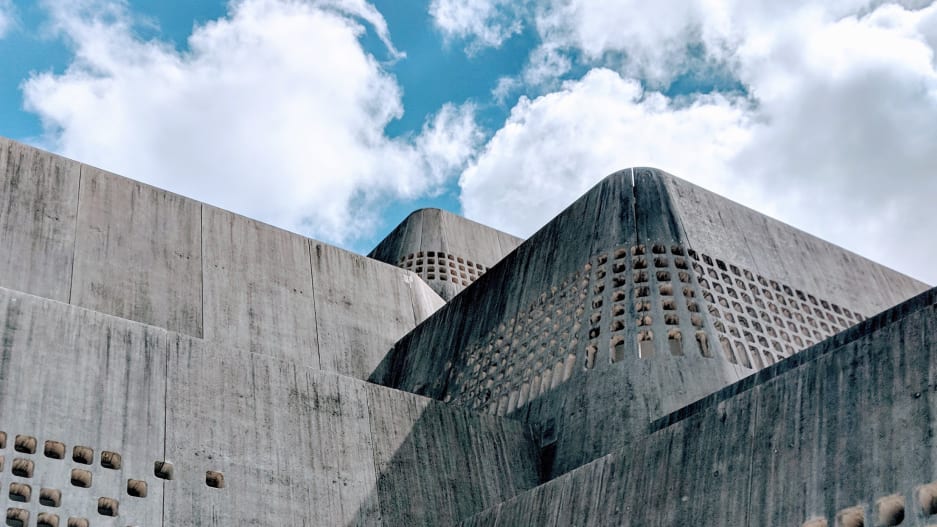- | 11:50 am
On this Japanese island, nearly every building is made of concrete

On the island of Okinawa, Japan, the chill vibes of a beach vacation hot spot have an unexpected architectural backdrop. Most of the buildings are made of harsh, imposing concrete.
The contrast is a result of the island’s unique conditions. A combination of climate and war have turned Okinawa into an accidental treasure trove of brutalism—the chunky concrete architecture that the architect Le Corbusier referred to as béton brut (raw concrete). One estimate suggests more than 90% of all new buildings constructed there are made of concrete.
Paul Tulett is a British-born photographer who lives in Okinawa and has been documenting the island’s concrete buildings on his Instagram account. He says they’re both a response to the island’s frequent typhoons and its rough years after enduring one of the most brutal battles of World War II, a conflict between U.S. and Japanese forces that lasted nearly three months and claimed hundreds of thousands of lives.
“This place got absolutely destroyed,” Tulett says. The seven-year postwar American occupation was one massive reconstruction effort, and concrete became a material of choice. “Let’s build quickly and cheaply. That’s all it was,” Tulett says. Throughout the 1950s, in Okinawa and around the world, brutalism boomed.
Now, 50 years after Japan regained sovereignty over Okinawa from the U.S., Tulett’s photography puts this utilitarian rebuilding into fresh light—at least for audiences outside Okinawa. He notes that “99.9% of the people that live here don’t give a f*** about what I’m shooting.”
Some are standout pieces of civic architecture on this island of 1.5 million people. There’s Nago City Hall, which looks like a collection of delicately stacked concrete Lego canopies. There’s also the Naha Prefectural Museum, with mesa-like forms and pocked windows that make it look like a stone version of an alien from Dr. Who.
Others are everyday buildings, from barber shops to modest homes. “Everyone’s a bit interested in brutalism now. ‘Ooh, isn’t it fancy,’” Tulett says. “But here it’s just what you do. It’s standard. Things have to be robust and typhoon-proof and that’s it.”
As one of the few places in Japan to record positive population growth rates, Okinawa is likely to continue to see concrete buildings rise. Though the huge carbon footprint of concrete has led many architects to move away from its use, Okinawans still rely on it for safety and utility. Tulett says he’s heard some local projects claim to be “eco-brutalism,” with less concrete and more sustainability features, but most are just conventional concrete construction. “Instead of béton brut, I call it béton necessaire,” he says.
Tulett says he came to appreciate and document these buildings by accident, after a winding education and career that went from chemistry to urban planning to counseling children and adults on the autism spectrum. “It’s a case of things threading together without you meaning to thread them together,” he says. “The photography was always in the background.”
After moving to Okinawa three years ago, Tulett was immediately drawn to the island’s concrete buildings. He was reluctant to open a social media account, but the prodding of friends convinced him there was a rabid audience on Instagram for the kinds of photos he was taking, especially anything considered brutalism. He now has more than 38,000 followers. His account handle, @brutal_zen, plays into this fascination, though he’s quick to argue that the term brutalism oversimplifies the rationale behind the architecture found in Okinawa. “It’s not really a case of whether it’s brutalist or not. It’s about whether it will stand up in a typhoon.”
Unexpectedly, Tulett has found himself a de facto authority on the subject. On March 30, the Japan Society in New York will host a webinar about the island’s unique architectural heritage, and Tulett will be on the panel to discuss his photography. He says he’s hoping to explain that it’s not just eye candy or an extension of the bleak and imposing Soviet-style architecture of massive housing blocks. The concrete architecture of Okinawa, brutalist or not, is a solution to a very specific set of problems. His photographs are a way to show that.
“I’m just interested in what’s around me and how well it’s being preserved,” he says. “Because it works.”





































